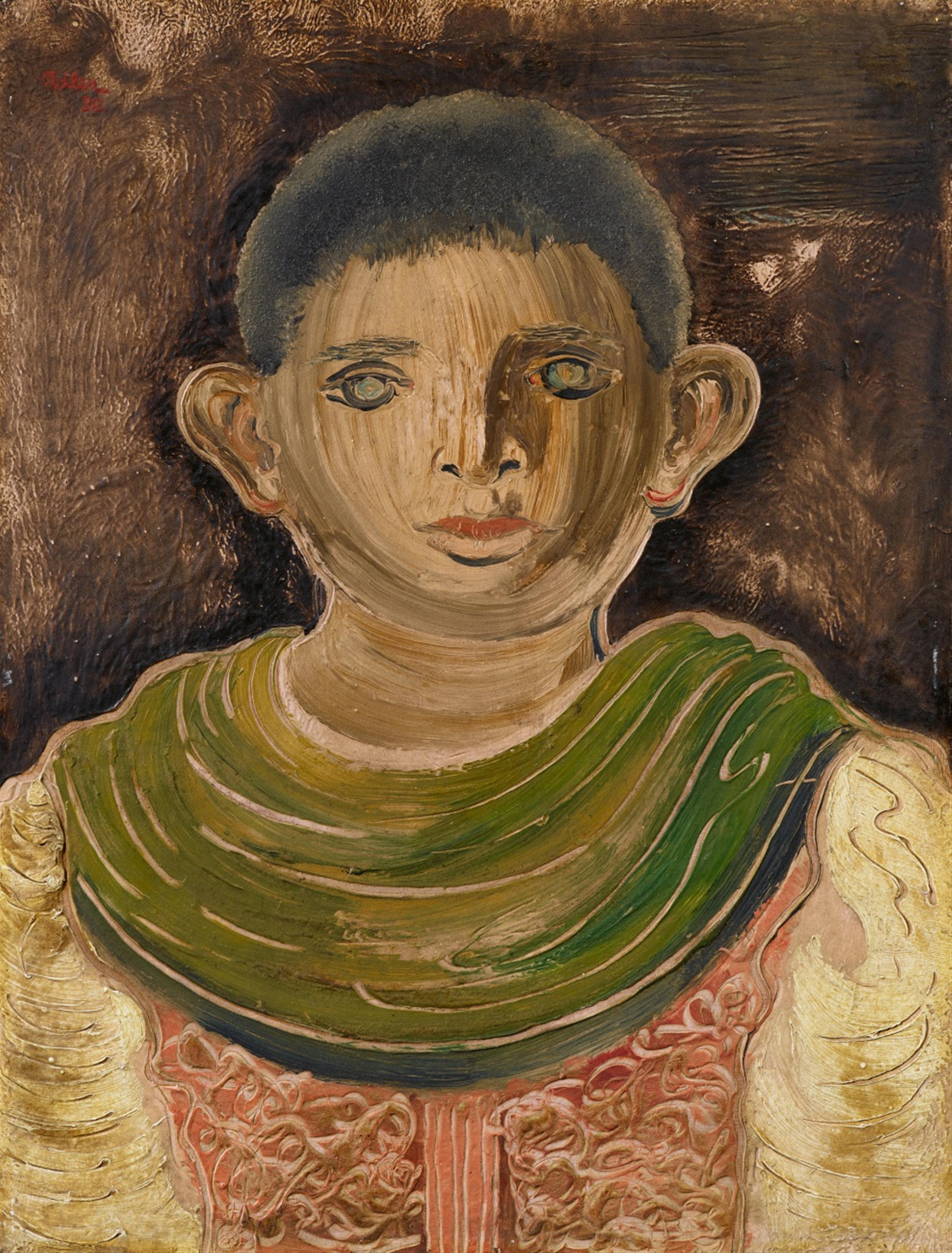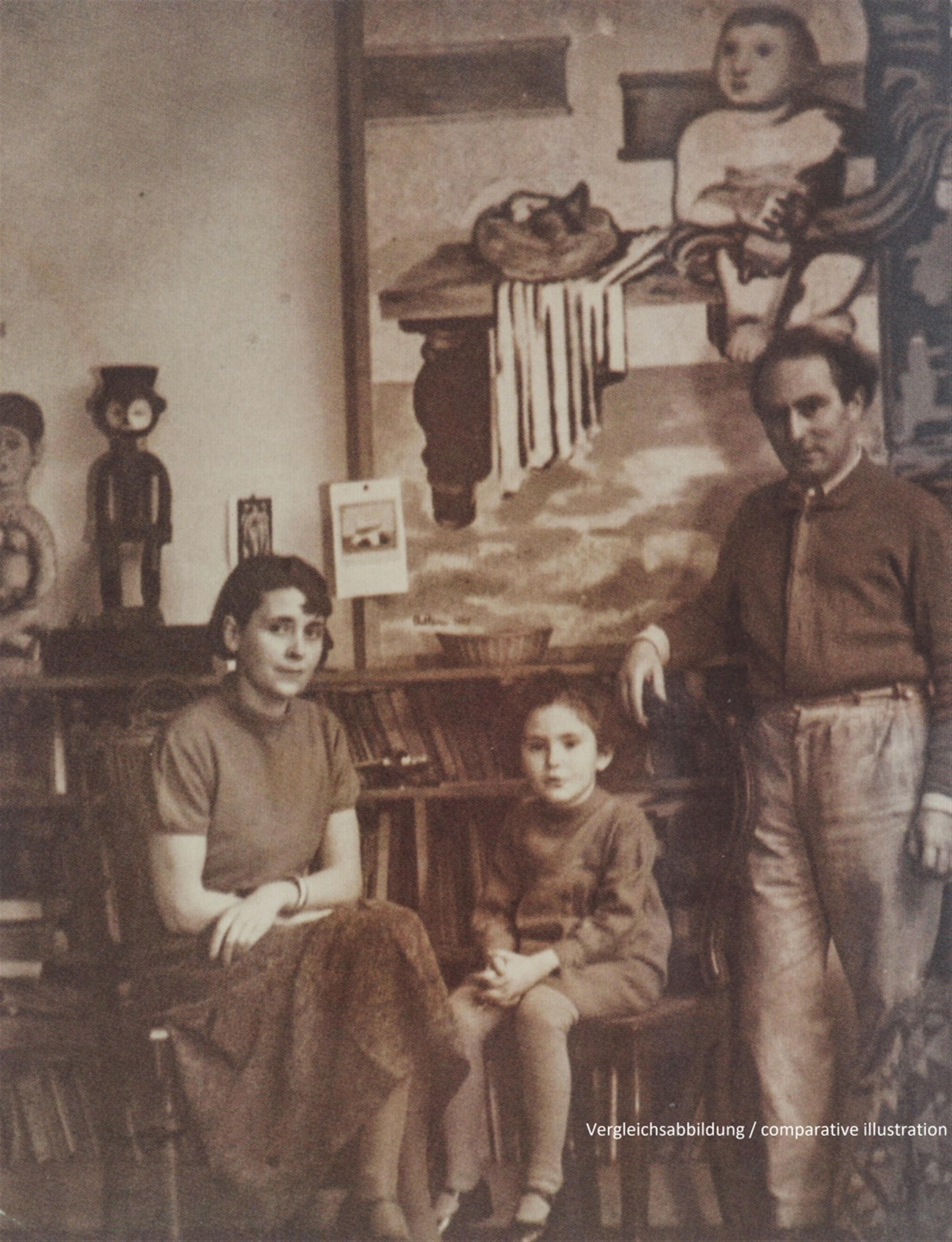Jankel Adler
Novillero I (Mallorquinischer Junge)
1930
Oil and plaster (textured) on wooden panel 62.8 x 48 cm With older white wooden bar, additionally framed. Signed and dated 'Adler 30.' in red upper left as well as signed in black brush verso and with artist's address: '(3)/ Jankel Adler Düsseldorf Liststr. 26', titled ' "Novillero I" ' below as well as dated and dedicated to his daughter Nina: 'Deyá auf Mallorca/ 1930/ für Nina'.
Jankel Adler's Spanish “Novillero” from the period of his stay on Mallorca takes the form of a portrait of a very young individual filled with the seriousness, pride and dignity of a fledgling matador. The artist has used the specific means provided by the colour as well as the painterly texture to suggest the preciously gleaming finery through the embroidered brocade that forms a part of it. Regarding this, Annemarie Heil mentions the torero's legendary “suit of lights”, the “Traje de luces”. In doing so, she incorporates a possible level of meaning, which subtly brings the antagonism of the motif as well as the myth of the corrida into play. This thematic aspect may - latently as well as deliberately, comparable to a fateful substratum - lie at the root of Jankel Adler's figure of the boy.
Created at the pinnacle of Jankel Adler's work as an artist, the present work takes its place among the body of work created towards the end of the 1920s in terms of its style and typology. In particular, the artist's wall-filling tableaux for the 1929 exhibition “Raum und Wandbild” at the Kölnischer Kunstverein should be mentioned - of these only the “Junger Arbeiter”, the central piece of “Familie” (1928), is still preserved today (Museum Sztuki, Lodz, see also comparative illus.). It is well-known that Jankel Adler maintained close ties to the Rhineland's “Gruppe progressiver Künstler”, centred around F.W. Seiwert and Heinrich Hoerle, and shared their ideals. In his art his specific image of the human being manifests itself not just through abstract and constructive tendencies but also through a monumental understanding of the figure. Both provide a means to express his quiet “humanitas”, and they also find themselves realised as aspects present in the likeness here. In this context, the concentrated and objectivised manner of the painterly composition in “Novillero” seems like a distant echo of the pictures of Oskar Schlemmer.
Catalogue Raisonné
Heibel WV 111/1930.08
Provenance
Nina Adler (Düsseldorf 1927 - 1992 Munich), estate; Galerie Remmert und Barth, Düsseldorf; Rhenish private collection
Literature
Jürgen Harten/Marc Scheps, Jankel Adler, exhib. cat. Städt. Kunsthalle Düsseldorf/ Tel Aviv Museum, Israel, Cologne 1985, Biographie, cf. p. 26 on the stay in Deyá/Mallorca; Annemarie Heibel, Jankel Adler (1895-1949), vol. II: Werkverzeichnis der Gemälde, Münster 2016, no. 111/1930.08 with colour illus.; Antje Birthälmer/Gerhard Finckh (ed.), exhib. cat. Jankel Adler, Wuppertal 2018, Neue Tendenzen in Adlers Malerei ab Mitte der 1920er Jahre, p. 303 f., with colour illus. p. 316; cf. Antje Birthälmer, Jankel Adler und die Kölner Progressiven, in: ibid., p. 89-113, especially p. 104-106, 108 ff.
Exhibitions
Düsseldorf 1995 (Galerie Remmert und Barth) Jankel Adler, 100 Werke zum 100. Geburtstag, cat. no. 19 with colour illus. p. 32 and front side of cover; Wuppertal 2018 (Von der Heydt-Museum), Jankel Adler und die Avantgarde, Chagall/Dix/Klee/Picasso, no cat. no. with colour illus. 316




